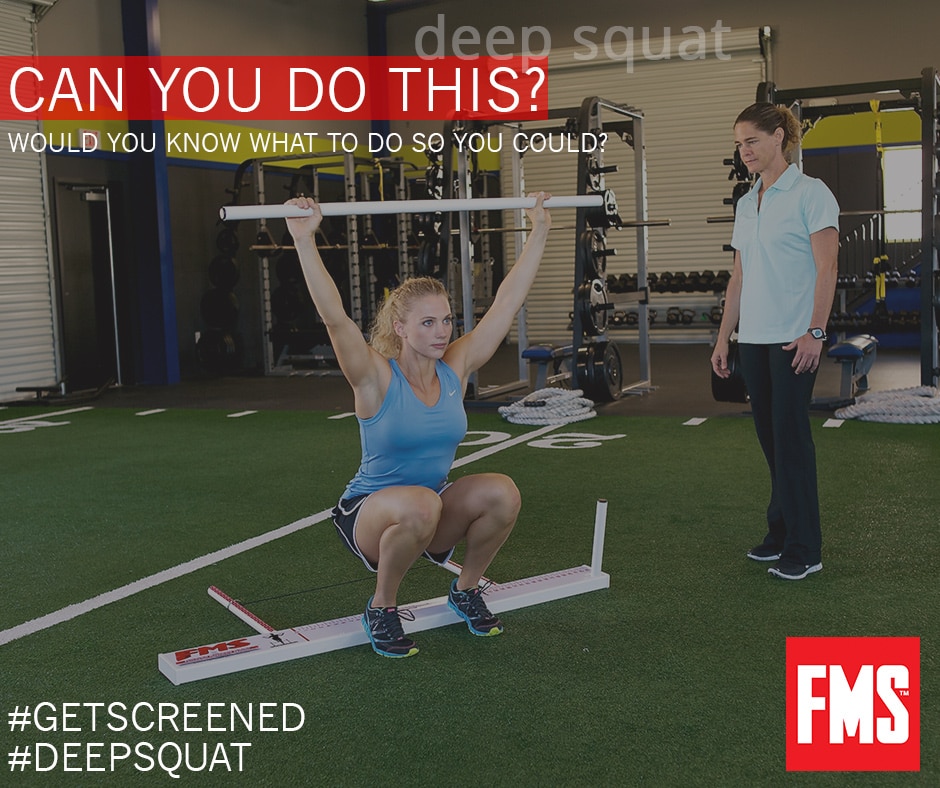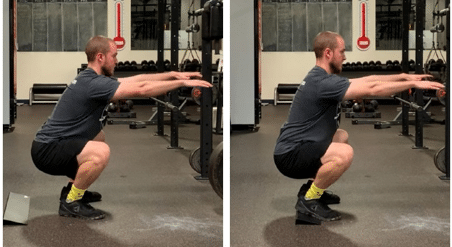Most people grasp the main technique points of squatting rather quickly. That is, they initiate a squat by reaching their hips back slightly, “spread the floor apart” on the way down, and “drive the ground away” to stand back up; there are other technique points of course, but those are the big ones.
Sometimes though, even when people nail the technique, the squat can feel foreign to them. Depending on someone’s mobility, training experience, and their anatomy, we may use a simple “trick” to help them.
We elevate their heels when they squat.
This helps for a couple of reasons, which we’ll discuss soon, and what most may not realize is they actually use this trick sooner than they think.
Members at BSP NOVA get a taste of heel’s elevated squatting in their assessment. When someone comes into BSP NOVA for the first time to meet with Chris Merritt, he takes them through the FMS (Functional Movement Screen). The first portion of this screen, the overhead squat, uses a heels elevated version of the squat if deemed necessary. Almost universally people’s squats improve, and they claim it feels better to them.

So what gives? Why does raising someone’s heel an inch, maybe inch and a half, make the squat look and feel so much better?
How elevating your heels instantly improves your squat
The difference you feel from elevating your heels when squatting can be such an improvement that it’s hard to believe. This is because adding a heel lift does two things:
- Creates less need for ankle range of motion (ROM)
- Creates a counterbalance
When squatting, our ankles must dorsiflex—think, toes move towards your shin—as we lower into the bottom position. If we don’t have sufficient ankle dorsiflexion (which can be assessed), it will throw off our mechanics because the range of motion to squat lower must come from elsewhere.
Essentially, by raising our heels off the floor we are starting off in more plantar flexion—think, toes move away from shins—than we normally would. By starting our squat in a greater degree of plantar flexion, we require less dorsiflexion to squat; we don’t “run out of room” in our ankles as quick.
To be clear: squatting better with a heel lift does not mean that the ankles are the reason for sure. We didn’t assess them directly so we can’t jump to that conclusion. It could be due to the counterbalance aspect as well.
A heel lift shifts our weight forward to start, which helps prevent us from feeling as though we’re falling back when we start a squat, making reaching our hips back to initiate the squat easier. The differences these two benefits create can also be seen in the picture below. A regular squat is shown on the left, while a heels elevated squat is shown on the right.

How We Use Heel Lifts at BSP NOVA
Squatting with a heel lift can be programmed or used in a number of ways:
a) it can be used to help our members with limited ROM in their ankles squat deeper—while we work on their ankle ROM too (if ankle ROM is the real reason);
b) it can assist them in learning the squat when starting out;
c) it can make the squat slightly more “quad dominant” if we want to stress the quads more
d) or, it can be used as a variation from regular squats for a time.
There is no one way that it must, or should, be used. It depends on the goal of the exercise, the individual and their individual needs and goals, and the availability of the heel lift (at BSP we have 4 heel lifts, but you can also use two 5 or 10 lb plates under your heels if needed).
One thing to note though, is that using a heel lift isn’t necessarily a crutch.
A few weeks ago, a BSP member said to me,
“I like how these feel, but I don’t want to use a crutch [heel lift] to squat.”
I’m glad she said that. The goal of using a heel lift isn’t to have that person using it until the end of time. If desired, we have two 1.5” heel lifts and two 1” heel lifts at BSP, so we can ween people away from the higher elevation and closer to the floor if desired.
The heel lift is a tool; and if that tool helps others squat better, then it’s worth trying.
As an aside: this heel elevation is also achieved through the use of Olympic weightlifting shoes (also referred to as squat shoes). These come with a built-in elevated heel which can make them a great choice for squatting—among other reasons like the midfoot strap and stable sole.
Should YOU elevate your heels when you squat?
It depends. If it allows you to squat deeper or with more ease in general, then give it a whirl. If you don’t notice much of a difference, or feel squatting normally is great, then you don’t have to; heel lifts are not a necessity by any means, but they can be a helpful tool. And if that tool helps put our members in the best position to be successful, then we’ll use it.
